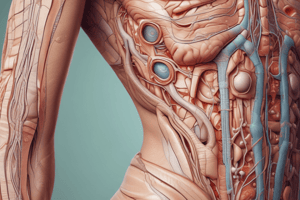Podcast
Questions and Answers
What is the average weight of the skin?
What is the average weight of the skin?
4 kg
What is the area covered by the skin in square meters?
What is the area covered by the skin in square meters?
2 m2
What are the three layers of the skin?
What are the three layers of the skin?
- Epidermis
- Dermis
- Hypodermis
- All of the above (correct)
What percentage of basal cells in normal skin are preparing for division?
What percentage of basal cells in normal skin are preparing for division?
What is the journey of a cell from the basal layer to the surface of the skin called?
What is the journey of a cell from the basal layer to the surface of the skin called?
The epidermis contains blood vessels.
The epidermis contains blood vessels.
What type of epithelium does the epidermis consist of?
What type of epithelium does the epidermis consist of?
The deepest layer of the skin is called the ______.
The deepest layer of the skin is called the ______.
What are keratinocytes?
What are keratinocytes?
Flashcards are hidden until you start studying
Study Notes
Structure of the Skin
- Skin serves as the primary interface between humans and the environment, weighing approximately 4 kg and covering around 2 m².
- Acts as a protective barrier against external conditions and reduces loss of essential body constituents, particularly water.
- Composed of three main layers: epidermis (outer layer), dermis (middle layer), and subcutis or hypodermis (innermost layer with fat).
- The basal layer of the epidermis is a single layer of columnar cells anchored to the dermis via hemidesmosomes on the basement membrane.
Epidermis
- The epidermis is a stratified squamous epithelium with multiple layers of closely packed cells that become flattened and filled with keratins on the surface.
- It lacks blood vessels and varies in thickness: less than 0.1 mm on eyelids to nearly 1 mm on palms and soles.
- As cells die and are shed, they contribute to household dust; this constant turnover keeps skin integrity.
- Approximately 30% of basal epidermal cells are in the growth fraction, preparing for division.
Keratinocytes
- Keratinocytes are the primary cells in the epidermis, filling the spinous or prickle cell layer and generating keratins.
- They travel from the basal layer through prickle and granular layers to the surface, a process taking about 30 days known as epidermal turnover.
- Cell division is directed during the G1 phase, followed by RNA and protein synthesis, with DNA synthesis occurring during the S phase and cellular growth in the G2 phase.
- Inactive basal cells reside in the G0 phase but may reactivate to proliferate in response to injury.
- Cells are interconnected by gap junctions, enhancing communication and structural integrity within the epidermis.
Continuous Regeneration
- Stem cells located among the basal and interfollicular cells contribute to replenishing the epidermal layers and hair follicles.
- Mitotic activity occurs primarily in the deepest layers of the epidermis, maintaining a balance required for constant skin renewal and repair.
Studying That Suits You
Use AI to generate personalized quizzes and flashcards to suit your learning preferences.




